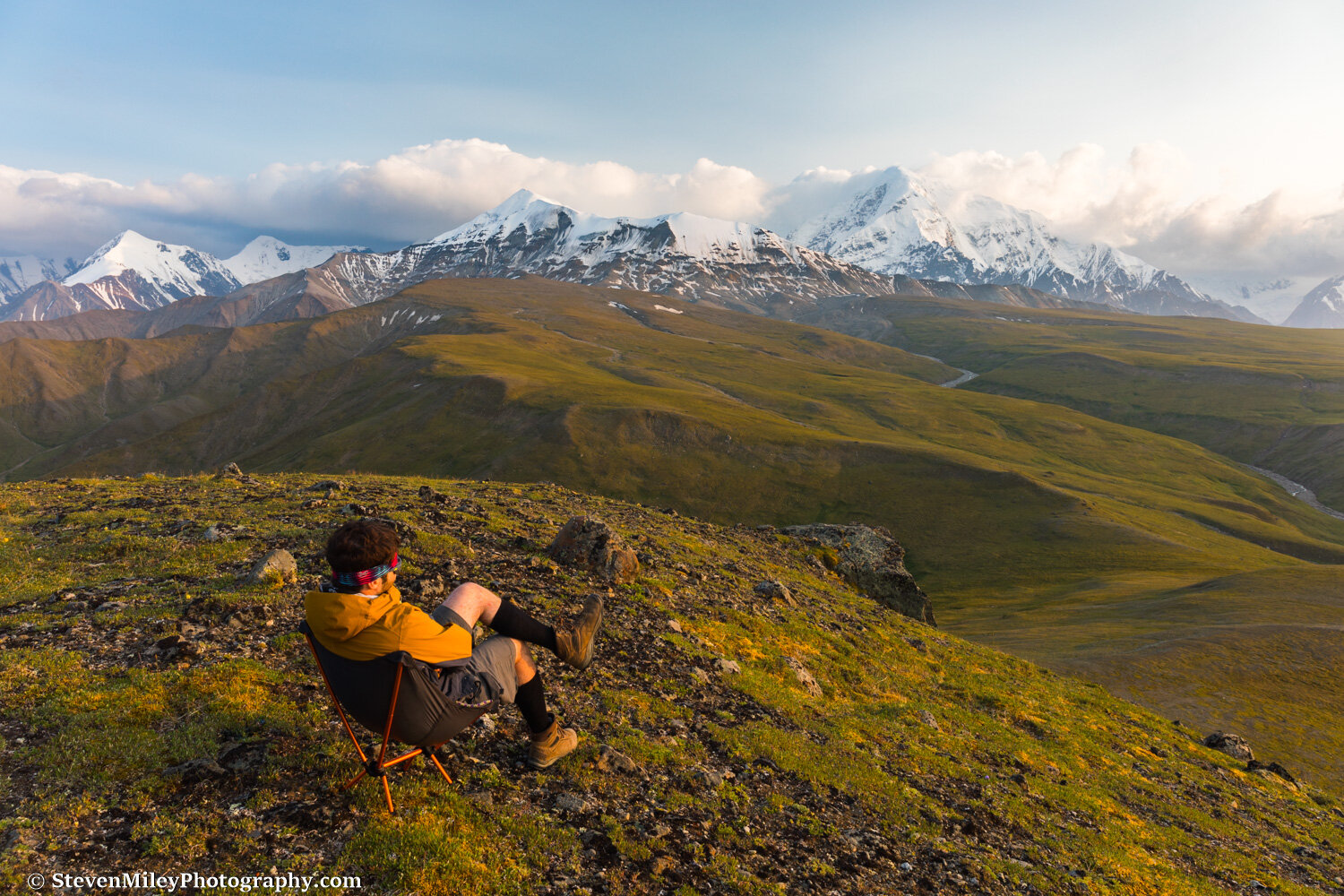Thanks to the coronavirus pandemic, I took most of my images last year in the eastern Alaska Range, which is basically in my backyard. Reduced services and travel restrictions made it difficult to explore many places in Alaska, including some of my favorite areas to hike and photograph like Denali National Park. I hope to visit more places this year including the Arctic, the Wrangells, Gakona Glacier, and more, but we’ll see how far I get. Below are my 10 favorite images from 2020, in no particular order.
1. Denali Spring Sunset
In the spring, I hiked up Primrose Ridge in Denali National Park on a beautiful day with Denali dominating the view in the distance. I shot this image at sunset with my camera operating on a timer from a 1000 feet or so away. You can read more about this adventure here.
2. Relaxing at Thayer Hut
I spent a couple nights at Thayer Hut this summer with my friends Brian and Steve. After a strenuous hike to the hut over Castner Glacier they chose to relax the next day near the hut. I took this shot of Steve reading the log book before I hiked up Mary’s Rock behind the hut, where I had an amazing view of all three branches of Castner Glacier and the Delta Mountains.
3. Black Rapids Glacier Overlook
After fixing up an old trail this summer, I took two friends and two dogs for a test hike. We waltzed through the mountains that day, stopping by this scenic cliff overlooking Black Rapids Glacier on our way to the ridgeline above the Jarvis Glacier valley. I took this image in the afternoon when the conditions were a bit hazy, so the color version is rather underwhelming, but the black and white version makes the location look iconic. Check out my trail guide if you want to experience this view, or book a hiking tour.
4. Castner Ice Cave Crystals
I shot this portrait of a customer in an ice cave that’s been at the front of Castner Glacier for several years now. During winter, ice crystals grow on the ceiling of the cave when the temperature plummets, but the cave has seen visitation rise significantly in the past two years so the crystals that hang low enough to reach don’t last long anymore before people knock them down. I took this shot using some flashes in a dark area of the cave where the crystals hang low enough to frame a subject, just a few days after they formed and a few days before these same crystals were destroyed.
5. Denali Aurora
This was my first aurora shot of the 2020-2021 season, taken from Denali Viewpoint South north of Talkeetna in late August. The weather was poor elsewhere in Alaska so I traveled here to find clear skies with a client. I’d like to take another shot here on a moonlit night with a brighter aurora and perhaps my 135mm f/1.8 lens to better accentuate Denali’s size. Click here for aurora tour info.
6. Canwell Glacier Sunset
On my second trip to MacKeith Hut, I found myself climbing up the final slope above Canwell Glacier at sunset while my two companions followed behind. Sometimes awesome shots present themselves like this and all I have to do is press the shutter button. Glacier ice beautifully reflects sunset colors but the geometry necessary for a good reflection doesn’t exist for many glaciers, so I just haven’t seen many images like this.
7. MacKeith Hut Twilight
Here’s another shot of MacKeith Hut with Icefall Peak in the background taken under twilight. This exposure took 5 minutes so I had plenty of time to brush my teeth before it completed.
8. Castner Glacier Ice Cave Exploring
Fire just looks cool against glacier ice. This was a fun day of solo ice cave exploring on Castner Glacier.
9. Breakup Lake
This lake only exists for a short time during breakup and the early part of summer as it quickly drains afterward, becoming two separate smaller ponds and then drying up completely. Breakup isn’t the best time for landscape photography in Alaska—I’d say it’s the worst—but I get a feeling of rejuvenation during breakup when the days get longer and warmer after a long, cold, dark winter, and this shot reminds me of that feeling. I also recall this morning vividly because a wolf walked around the far side of the lake, passing within a few dozen yards of me. I hoped the wolf would continue circling around the lake right in front of me as I stayed hidden, but it continued past and I couldn’t get any close shots.
10. Canwell Glacier Ice Cave
I found this ice cave at Canwell Glacier on a beautiful day in March, just before the pandemic took hold in the United States. The Alaska Range received a ton of snow that winter, and a big wind event just a day or two prior covered much of the area near the toe of the glacier in snow drifts, some several feet thick. The steep snow drift in this cave made me a bit hesitant to enter, and this shot of my buddy Steve looking hesitantly inside reminds me of all the times I’ve surveyed an ice cave wondering whether it was safe enough to enter.

















